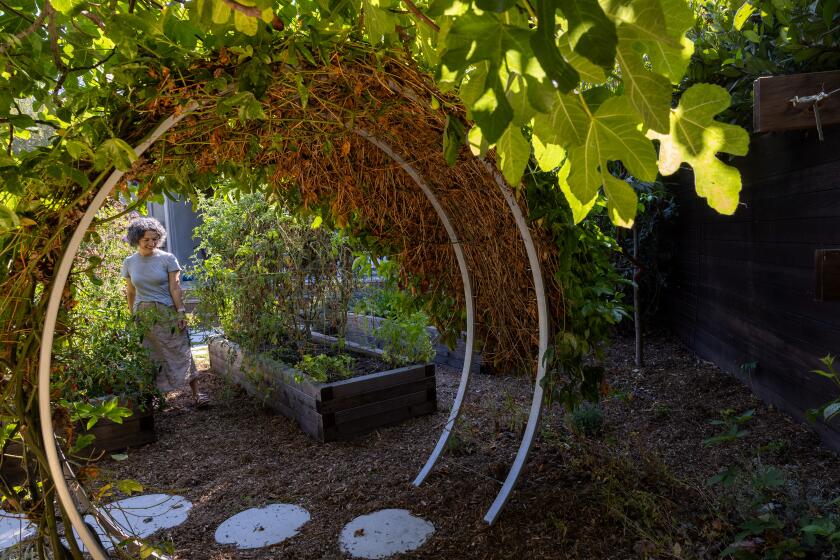PRACTICAL VIEW / THE ASCENT OF FAKE FLOWERS : It’s a Blooming Inundation
Arose by any other name might be latex. Or velvet, polyester, parchment or silk.
But don’t call it fake. And definitely don’t call it artificial.
Florists prefer to call these flowers permanent , thank you very much.
And in recent years, these floral imitators have edged their way onto florist shelves in Southern California, the fresh-flower center of the United States.
Forget those plastic sunflowers of the 1950s that had to be hosed down once a week for maintenance. The artificial flowers of the ‘90s look real enough to fool the Azalea Society, might have a whiff of perfume for essence and sport a new repellent-type spray that keeps the dust off.
And they have class--and fans.
* At California Floral Co. in downtown Los Angeles, Johnny Huynh points to a shelf lined with vases of red and pink roses.
“Artificial flowers? You bet. A few years ago we only had two arrangements here--now we have a lot. My customers buy them for their offices. . . . The price is compatible and they’re looking better all the time.” (A nearby customer has another reason for preferring permanent: “I buy them for my aunt who has allergies.”)
* At the Flower Meadows in Beverly Hills, florist Carol Haley says the economy has dictated a new inventiveness.
Customers will buy a silk or dried arrangement and add a fresh flower or two. “You have to keep up with the trends--some of the new silk flowers are absolutely phenomenal.”
The English garden look--a mass of dahlias, roses, lilacs, peonies, larkspur and delphinium--is popular for dining-table centerpieces, she says.
* At EverThine on Third Street and Edinburgh Avenue, owner May Berns plucks a stem of exquisite butterfly orchids from a floral bank and hands it to a visitor. “It’s $28 and very popular.” The most popular, she adds, is the rose (prices range from $1 to $55 a stem), followed by gladiolus, tulips and iris.
After more than 30 years of selling both fresh and silk flowers, she dropped fresh several years ago because silk looked like the “thing of the future.” Now she stocks thousands of flowers and plants, including the hardy polyesters that thrive outdoors posing as geraniums, chrysanthemums, azaleas and pansies. One customer buys showy bougainvillea sprays to supplement the garden vines in off-seasons.
Still, there are times when wanna-bes just won’t do.
At the Cafe Del Rey in the Marina, manager Anthony Miller surveys his airy, open dining room, each table adorned with fresh magenta Peruvian lilies.
“We’ve used artificial flowers in our restaurants in other cities, and some look very, very good,” he says. “But we opt for fresh here because we want to make sure everything is as natural as possible--even the ingredients in our food. It’s a statement we’re trying to make.”
Purists and garden club members might turn up their noses at the thought of silk lilacs with latex leaves and French-wrapped stems, but florists, who once rejected anything smacking of fake flowers, are now stocking the unreal thing in increasing numbers.
The ‘90s economy has played a role, says Sharon French at the Society of American Florists. “People are looking for things that are a little more permanent.”
Although no statistical breakdown is available, she estimates that permanent flowers accounted for 10% of last year’s $12.9 billion in industry retail sales.
The rise in popularity also is attributed to a number of practical features.
* They’re allergy-free.
* They’re easy to maintain. (You don’t have to remember to change the water or add life-prolonging nutrients.)
* They can last a lifetime; real flowers, a week at best.
* Although they can be quite expensive, they’re still, dollar for dollar, the better buy. A dinner-table centerpiece can range from $40 to $1,000 depending on the length of the table and the host’s budget.
But the real magic wand has come from the chemistry labs.
Selwyn Grant, whose NHM Corp. in Hollywood has been importing and distributing artificial flowers for 40 years, says most “silk” flowers are really new polyesters with none of the disadvantages of silk. (“Even the fake is fake,” sniffs one botanist.)
“It can be dyed color-fast, it has memory--will retain the shape it was molded in--and it has a negative static charge so it tends to repel dust,” says Grant.
Japan produces most of the polyester used for artificial flowers, utilizing a very fine thread. Leaves, petals and stems for each design are cut from the fabric bolt with a hand press. Then they are welded into a unit under heat and pressure in a mechanically assisted mold.
The process involves a lot of hand labor, says Grant. “China is far and away the biggest provider, with Thailand a far second.”
Artificial flowers today might be showing up at the best parties and dinner tables--even in an occasional bridal bouquet--but there’s one role they still can’t play: No one who wants to say “I love you” with flowers picks polyester. That’s courting disaster.
“When a man gives to a woman--or vice versa--they always pick real,” says florist Huynh. “Otherwise, it just seems a little cheap.”
Even beautiful, expensive, realistic, long-stemmed silk roses won’t do, acknowledges florist Berns. “I’ve tried to interest customers, but they still want real flowers.”
That’s because the medium is the message, says Beverly Hills florist Bob Andersen.
“For romantic purposes you always go with the fresh. You’re not sending flowers, you’re sending thoughts and emotions. If the medium is artificial, so is the thought.”






